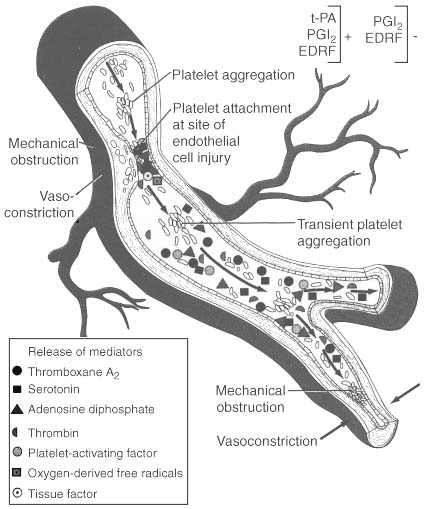 |
 |
Figure 50-5
Mechanisms involved in thrombosis and vasoconstriction
at sites of atherosclerotic plaque injury resulting from plaque ulceration or fissuring
caused by interventional therapy with angioplasty or stents and other injuries to
endothelium. With such injury, the subendothelium is exposed, platelets adhere and
aggregate, and local accumulation of mediators occurs, largely platelet derived,
including thromboxane A2
, serotonin, adenosine diphosphate, thrombin,
platelet-activating factor, oxygen-derived free radicals, tissue factor, and endothelin.
These mediators promote the growth of thrombus, and most are vasoconstrictors.
Several mediators are also mitogens that promote fibroproliferation or exuberant
scarring after endothelial injury (i.e., "restenotic lesion"). At sites of vascular
injury there are reduced concentrations of normally present endogenous substances
that prevent thrombosis, vasoconstriction, and inflammation, including tissue plasminogen
activator (tPA), prostacyclin (PGI2
), and nitric oxide (tPA, PGI2
,
and endothelium-derived relaxing factor [EDRF] at top right).
Loss of these normally present protective substances helps create a prothrombotic
environment and one in which inflammation and fibroproliferation occur after endothelial
injury. (From Willerson JT, Cohn J [eds]: Cardiovascular Medicine, 2nd
ed. New York, Churchill Livingstone, 2000.)

 |
